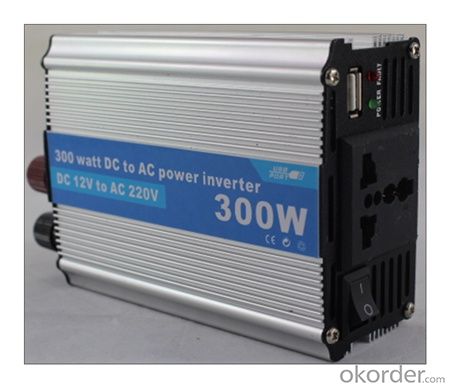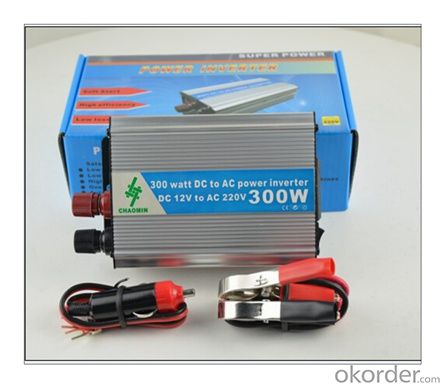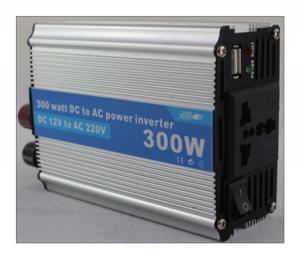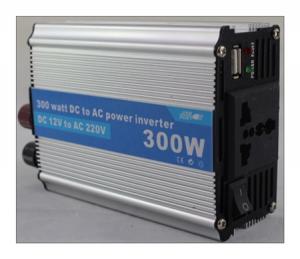Solar Charging Hight Quality Useful Discharging Controller 300W
- Loading Port:
- China main port
- Payment Terms:
- TT or LC
- Min Order Qty:
- 100 unit
- Supply Capability:
- 10000 unit/month
OKorder Service Pledge
OKorder Financial Service
You Might Also Like
1, Product desciption
Inverter circuits designed to produce a variable output voltage range are often used within motor speed controllers.
The DC power for the inverter section can be derived from a normal AC wall outlet or some other source. Control and feedback circuitry is used to adjust the final output of the inverter section which will ultimately determine the speed of the motor operating under its mechanical load.
Motor speed control needs are numerous and include things like: industrial motor driven equipment, electric vehicles, rail transport systems, and power tools. (See related: variable-frequency drive ) Switching states are developed for positive, negative and zero voltages as per the patterns given in the switching Table.
The generated gate pulses are given to each switch in accordance with the developed pattern and thus the output is obtained.
2, Features of the product
Inverters convert low frequency main AC power to higher frequency for use in induction heating.
To do this, AC power is first rectified to provide DC power. The inverter then changes the DC power to high frequency AC power. Due to the reduction in the number of DC Sources employed, the structure becomes more reliable and the output voltage has higher resolution due to an increase in the number of steps so that the reference sinusoidal voltage can be better achieved.
This configuration has recently become very popular in AC power supply and adjustable speed drive applications. This new inverter can avoid extra clamping diodes or voltage balancing capacitors. There are three kinds of level shifted modulation techniques, namely:
The first thing to figure out is the length of road in need of street lights.
This can be a small entrance road only a couple hundred of feet long to miles of streets through an area. Does the area currently have any type of lighting available.
What is the reason for needing street lights in this area
Is the electrical grid already nearby or would you need to call in the power company to bring in electrical lines.
If the electric needs to be brought to the area, how much is this going to cost? Depending on how far the grid electric is from the location of the needed lighting, this can be quite expensive.
How much lighting is needed on the street? Do the lights need to be dark sky compliant.
Do the street lights need to run from dusk to dawn or for only a specified number of hours at night.
Are the street lights able to dim in the middle of the night and still provide enough lighting.
These questions need to be answered before you can decide on how many lights you will need to complete the project.
3, Product Image


4, Detailed Specification
Specification:
Model | Tracer |
Rated system voltage | 12/24V auto work |
Rated battery current | 40A |
Rated load current | 20A |
Max.battery voltage | 32V |
Max.PV open circuit voltage | 100VDC |
Max.PV input power | 12V 500W, 24V 1000W |
Self-consumption | <10mA(24V) |
Charge Circuit Voltage Drop | ≤0.26V |
Discharge Circuit Voltage Drop | ≤0.15V |
Communication | TTL232 / 8 pin RJ45 |
Temp.compensation | -5mV/℃/2V |
Working temperature | -35℃~+55℃ |
Storage temperature range | -35℃~+80℃ |
Humidity | 10%-90% NC |
Enclosure | IP30 |
Altitude | ≤3000m |
Dimension | 242mm x 169mm x 91mm |
Mounting holes | 180mm x 160mm |
Mounting hole size | Φ5 |
Terminal | 25mm2 |
Weight | 2.05kg |
- Q:Can a solar controller be used with solar panels of different mounting systems?
- Indeed, solar panels with various mounting systems can be utilized in conjunction with a solar controller. The principal role of the solar controller is to oversee the charging process of batteries within a solar power setup, guaranteeing their efficient charging and safeguarding against overcharging or discharging. Its functionality is not contingent upon the particular mounting system employed for the solar panels. The solar controller establishes a connection to the battery bank and regulates the energy flow from the solar panels to the batteries. As long as the solar panels are correctly linked to the solar controller, it can be employed irrespective of the mounting system utilized for the panels.
- Q:How does a solar controller handle the protection against voltage fluctuations?
- A solar controller handles the protection against voltage fluctuations by monitoring the voltage levels from the solar panels and regulating the flow of electricity to prevent damage to the battery or other connected devices. It ensures that the voltage is maintained within a safe and optimal range by adjusting the charging and discharging rates, thus safeguarding the system against overcharging, overvoltage, and other potential issues caused by voltage fluctuations.
- Q:Are there any environmental benefits of using a solar controller?
- Yes, there are several environmental benefits of using a solar controller. Firstly, solar controllers help optimize the performance of solar panels, allowing for maximum energy generation from sunlight. By utilizing solar energy, we reduce our reliance on fossil fuels, which helps reduce carbon emissions and combat climate change. Additionally, solar controllers enable efficient energy storage and distribution, reducing wastage and promoting a more sustainable energy system. Overall, the use of solar controllers contributes to a cleaner, greener environment and a more sustainable future.
- Q:Can a solar controller be used with solar-powered indoor industrial buildings?
- Yes, a solar controller can be used with solar-powered indoor industrial buildings. A solar controller, also known as a charge controller, is an essential component of a solar power system. Its main function is to regulate the voltage and current from the solar panels to ensure efficient charging and prevent overcharging of the batteries. In the case of solar-powered indoor industrial buildings, the solar controller plays a crucial role in managing the flow of electricity generated by the solar panels. It helps optimize the energy production and delivery to power various equipment and systems within the building. The solar controller ensures that the batteries are charged properly and maintains a stable power supply to the indoor industrial building. It also protects the batteries from damage caused by overcharging or excessive discharge, which can extend their lifespan and overall system efficiency. Additionally, a solar controller can provide monitoring and control capabilities, allowing users to track the performance of the solar panels and batteries. This data can be used to optimize energy usage, identify potential issues, and make informed decisions to improve the overall efficiency of the solar-powered indoor industrial building. Overall, a solar controller is an essential component for managing and optimizing solar power systems, making it suitable for use in solar-powered indoor industrial buildings.
- Q:What is the role of a USB charging port in a solar controller?
- The role of a USB charging port in a solar controller is to provide a convenient and versatile way to charge electronic devices using solar power. It allows users to connect their devices directly to the solar controller, harnessing the energy from the solar panels to charge their devices efficiently and sustainably.
- Q:Can a solar controller be used with AGM batteries?
- Yes, a solar controller can be used with AGM (Absorbent Glass Mat) batteries. AGM batteries are a type of lead-acid battery and can be charged using a solar controller. The solar controller helps regulate and optimize the charging process, ensuring the AGM batteries receive the appropriate voltage and current from the solar panels.
- Q:What is the maximum load voltage that a solar controller can handle?
- The maximum load voltage that a solar controller can handle depends on the specific model and its design. It is typically mentioned in the product specifications provided by the manufacturer.
- Q:How does a solar controller handle the logging of system data?
- A solar controller handles the logging of system data by continuously monitoring and recording various parameters such as solar panel voltage, battery voltage, charging current, and load current. It stores this data in its internal memory or an external storage device such as an SD card. This logged information can then be accessed and analyzed by users to track the performance, efficiency, and overall health of the solar system.
- Q:How does a solar controller monitor the battery voltage?
- A solar controller monitors the battery voltage by continuously measuring the voltage level of the battery. It uses built-in sensors and circuitry to accurately measure the voltage and then adjusts the charging and discharging processes accordingly to maintain the battery within safe voltage limits.
- Q:Can a solar controller be used with a solar-powered healthcare facility?
- Yes, a solar controller can be used with a solar-powered healthcare facility. A solar controller is an essential component of a solar power system as it regulates the charging and discharging of batteries, ensuring optimal performance and protection. In a solar-powered healthcare facility, the solar controller will effectively manage the energy generated by the solar panels, storing it in batteries for use during periods of low sunlight or increased demand. This ensures a consistent and reliable power supply, supporting the healthcare facility's operations and providing uninterrupted healthcare services.
1. Manufacturer Overview |
|
|---|---|
| Location | |
| Year Established | |
| Annual Output Value | |
| Main Markets | |
| Company Certifications | |
2. Manufacturer Certificates |
|
|---|---|
| a) Certification Name | |
| Range | |
| Reference | |
| Validity Period | |
3. Manufacturer Capability |
|
|---|---|
| a)Trade Capacity | |
| Nearest Port | |
| Export Percentage | |
| No.of Employees in Trade Department | |
| Language Spoken: | |
| b)Factory Information | |
| Factory Size: | |
| No. of Production Lines | |
| Contract Manufacturing | |
| Product Price Range | |
Send your message to us
Solar Charging Hight Quality Useful Discharging Controller 300W
- Loading Port:
- China main port
- Payment Terms:
- TT or LC
- Min Order Qty:
- 100 unit
- Supply Capability:
- 10000 unit/month
OKorder Service Pledge
OKorder Financial Service
Similar products
New products
Hot products
Hot Searches
Related keywords































